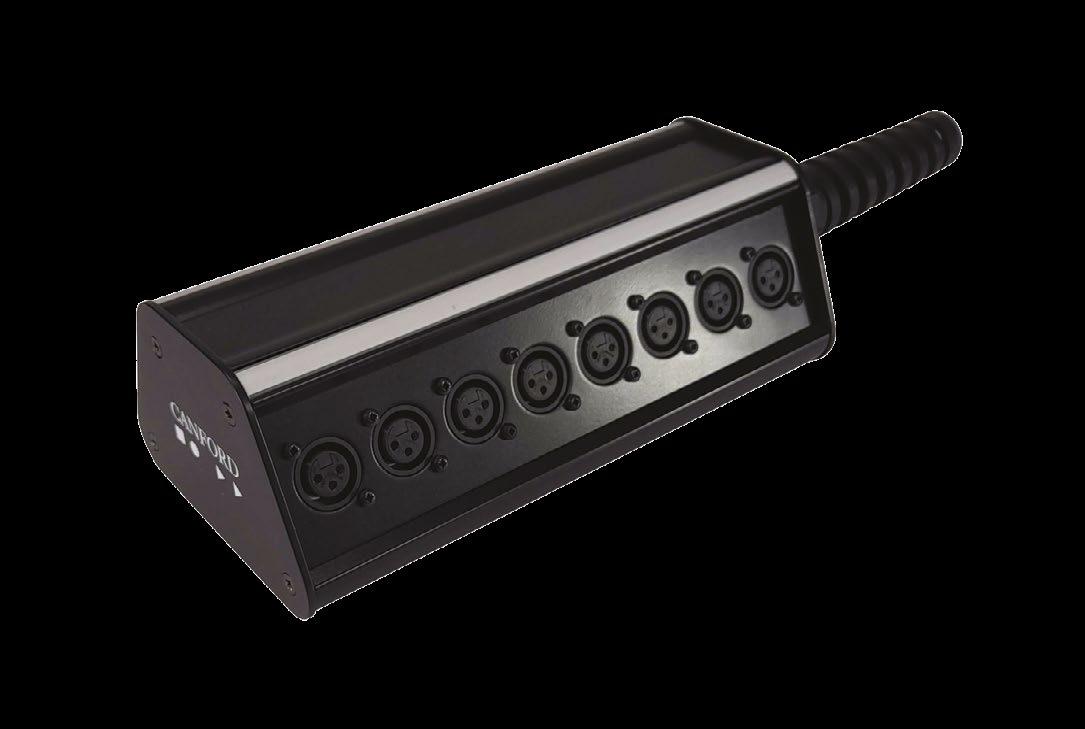
6 minute read
Why a Yellobrik isn’t just a Brick
WHY A yellobrik
ISN’T JUST A BRICK
By Dave Holloway, LYNX Technik Director of Sales EMEA
There can be no doubt that the humble ‘throw down’ brick as our American cousins would call them, (although we don’t recommend throwing equipment around) has played a vital role in broadcast systems for many years. Originally conceived as economical and convenient ‘glue’ to add some basic standalone functionality and fibre or format conversion to the periphery of a larger system, the now ubiquitous yellobrik functionality continues to grow. Often in temporary systems or emergency situations, a modular brik is an ideal solution. We know many OB and Fly-away system facilities providers who carry a ‘First Aid Toolbox’ of yellobriks allowing them to rise to unexpected challenges on site. From long distance fibre extensions around obstacles that weren’t there during the survey, emergency fibre switching, 12G SDI format conversion, embedding additional audio feeds, generating Reference signals and frame synchronisation, to converting to a range of output formats for surprise additional feed or monitoring requirements, yellobrik has it covered.

But there are concerns and drawbacks to a modular approach in critical path or core infrastructure. Reliability is probably the biggest concern for the programme maker or broadcaster. The LYNX reputation for reliability stems from attention to detail and control in all areas. Hardware and software design, and manufacturing takes place in Germany in our ISO 9001 Certified environment. Cost is obviously a big consideration for us, and the user, but we believe reliability and long-term value are more important. We will not compromise quality, performance, reliability, and support for the sake of a few Euro saving in the short term. The unrivalled reputation of yellobrik and their extensive use in live broadcast critical paths validates our quality driven philosophy. Some aspects however are beyond our control. The provision of a redundant AC system power supply is an obvious precautionary measure built into most critical systems, but where does that leave the brik with its single AC/DC power adapter and single inlet socket. Lynx Technik offer a solution in the form of the yellobrik Rackframe which not only accommodates up to 14 modules in as little as 1U of rack space but can optionally have a second external AC/DC power supply connected ensuring a seamless switch from the primary to backup AC should one source fail. The modules simply plug in to the rackframe slots and onto the fixed DC connectors and are locked in place from the rear. No DC cables are required to each module and GPI/O contacts allow monitoring of the rackframe power supplies. Having set the standard for reliability and redundant power support, LYNX have pushed the boundaries of what can be achieved in a compact module. Currently the range includes: • 4K format conversion (SQD<>2SI<>12G coax) • Frame Synchroniser • UPXD Converter / Scaler • HDMI <> SDI Conversion • Audio Embedding/De-embedding • Opical <> Copper conversion • Optical Switching • Quad Split Multiviewer • H.264 Encoder and Recorder - most with fibre SFP options. Along with a range of passive CWDM multiplexer modules, the fibre transmission range offers the options of: • Copper to SM or MM fibre • Bi-Directional WDM on a single fibre • 18 channels of CWDM multiplex fibre - for transport of SDI from SD to 48K, Audio, MADI, Sync/
Analogue video, 10G and Gigabit ethernet and RS serial data/GPI and vice versa of course. With the increases in functionality and the confidence of redundant powering, we continually see broadcast organisations incorporating yellobriks as permanent core infrastructure, both static and mobile. In fact, there are very few domestic and international sporting events and TV shows to which yellobrik has not made a vital contribution.

All yellobrik modules connected via the RCT 1012 yellobrik Rack Controller are visible, monitored, and configurable remotely over the IP network and can be controlled by virtually any automation system.
Most yellobriks have a variety of internal configuration setting, some accessible via external DIP switches, and all including routing or multi option parameters accessible via a mini-USB socket which must be connected to PC or Mac running the free of charge yelloGUI intuitive graphical configuration software. Incidentally, a configuration can be saved offboard and reinstalled as required or copied to other modules of the same type. All yellobriks retain their parameter settings through power-cycles, vital for OB/fly-away use. But what happens when a parameter change is needed? Local direct access to each yellobrik is required, which may be physically challenging, impractical and time consuming, particularly at large or multi tech-location venues or studio complexes. Remote production and contribution bring their own new challenges. Ideally there would be an access system allowing the user to configure, monitor and apply firmware updates to each yellobrik individually from any PC or Mac, via their local ethernet network, or a VPN to remote locations. In a perfect world, it would also interface with any existing automaton system and allow remote SNMPv2. control of the yellobriks by third-party software.
So, the RCT 1012 yellobrik Rack Controller was conceived.
The RCT 1012 is a compact one-slot yellobrik module designed to combine the control of up to 12 yellobrik modules via a single ethernet port. Each yellobrik is permanently connected by its mini-USB port to a USB socket on the RCT 1012, which in turn is connected by RJ45 to an existing ethernet network. The RCT 1012 automatically discovers the connected yellobriks and displays them in the installed yelloGUI control software anywhere on the network. This networked provides a system for management and dynamic control of multiple yellobriks without requiring the local individual USB connection to each module every time a change is needed. Status monitoring and alarm functions are also included for every processing yellobrik and for all future fibre TX and RX modules with a mini-USB port. To accommodate the increased configuration and monitoring capabilities and allow third party control of yellobriks, the next generation of the LYNX GUI has been introduced. Building on the established device tree structure of FlexGUI / APPolo Control for the series 5000 card and rackframe system, LYNXCentraal (yes, double ‘a’, not a typo) brings together total control and automation of series 5000, greenMachine and yellobrik in a single application for PC or Mac. (Fear not, for those not requiring this level of control a new version of the familiar yelloGUI is included in LYNXCentraal.) So the yellobrik has truly come of age. Remote configuration and control, reliability and redundant power backup give the system designer the confidence to fully integrate yellobrik in automated, monitored and possibly remote core infrastructure. All LYNX Technik equipment carries a 3-year warranty as standard, with optional extensions available. Manuals and a comprehensive Online Knowledgebase provides answers to most questions with email and telephone technical support and software updates provided free of charge for the life of the product. Finally, there is a fixed rate repair or replace service for out of warranty equipment for the whole of its production life, and for seven years after we discontinue a product.
® LYNXTechnik AG
Broadcast Television Equipment
www.canford.co.uk/Lynx











